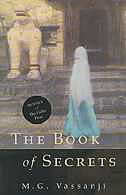 Kevin Steele’s Photo Menu page has a large collection of small photo essays by Steele. He has a nice clean touch – small numbers of images arranged on a white background using repetitions of different elements.
Kevin Steele’s Photo Menu page has a large collection of small photo essays by Steele. He has a nice clean touch – small numbers of images arranged on a white background using repetitions of different elements.
Steele is a designer who cofounded Mackerel an innovative early Toronto multimedia company that Cory Doctorow says,
“Together, they built the first iteration of a project that would go on to virtually create the market for multimedia in Canada. They laughed. They smoked. They blew a bunch of doobs.”
Previously I blogged his new site for Smackerel where he and David Goff have some great essays on early multimedia – see Mackarel Smackarel.

 I just finished The Book of Secrets by
I just finished The Book of Secrets by